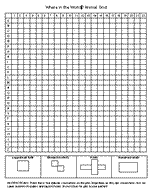Where
in the World?
Understanding
Latitude and Longitude
Overview: Students play a grid-based game and devise clues to help classmates locate spots on the globe. In doing so, they come to recognize the value of using latitude and longitude for identifying locations.
| Time Materials |
|
| Hidden
Animals Animal Grid |
|
 |
|
Students participating in Journey North must understand geographic location. Every spot on the Earth can be described in both relative and absolute terms. In our everyday lives, we think mainly about relative location: Where places are in relation to other places. Is it close by? Can I get there from here? What else is nearby?
In Journey North, absolute location is important. Using a mathematical grid system (in this case, latitude and longitude), any spot on earth can be identified with just two numbers. In order to track mystery classes, migrating species, blooming plants, and other signs of spring, students should know how to use latitude and longitude with ease. This lesson lays the groundwork by helping students recognize the value of using a grid system for finding locations.
Laying
the Groundwork
Write these sentences on the board:
- My house is close to the mall.
- John's house is on the corner of Maple Street and Elm Avenue.
- My cousin's house is in a small Texas town named Beeville.
Ask, Which of these statements would be most useful in helping you find the house that's mentioned? Have them explain their thinking. Accept their responses and encourage discussion. Finally, invite the class to explore different ways of describing locations.
Exploration #1: Hidden Animals
- Invite
the class to play an animal variation of the "Battleship"
game. Divide the class into pairs and give each student a copy of the
Where in the World? Animal Grid. (You can get this in Microsoft
Word or pdf format.)
- Ask partner
#1 to hide the four migratory animals somewhere on the grid, but not
to show the grid to his or her partner. Partner #2 must then guess coordinates
(e.g.,
C,8) to locate the animals. Partner #1 should respond "yes"
or "no" to each guess to indicate whether
any part of an animal touches those coordinates. Partner #2 should
use a blank
grid to mark responses and narrow down the possible locations
for each animal. Partners should switch roles when one has uncovered
all the animals.
- Ask the
class, Was
the
grid/coodinate
system
helpful
in
finding
the animals? Why or why not?
If students are unfamiliar with latitude/longitude lines on maps, explore a map together. Ask them to describe things they notice about it. If they don't point out the lines running across the page (latitude) and lines running up and down (longitude), ask them if they see any type of grid. Ask, Why do you think these lines are drawn on many maps? Discuss the way the lines are numbered and share as much detail as is appropriate for your grade range.
Exploration #2: Mystery Beaches
- Ask student
pairs to use a map to identify a beach where they'd like to picnic.
It should be on a lake or ocean somewhere in the Western Hemisphere.
Have them record the latitude or longitude coordinates, remembering
to identify appropriate compass directions (north, south, east, and
west).
- Ask each
pair to write down five to ten clues that would help others locate their
beach on a map. Each new clue should help someone narrow down the location;
the last clue should give the latitude/longitude coordinates. See the
following example:
The beach is located in the United States.
It stays warm here all year long.
Everglades National Park is in the state where this beach is located.
The beach is on the East Coast.
It is north of Miami and south of Fort Pierce.
It is directly south of the intersection of 27° latitude north and 80° longitude west.
(It is Palm Beach.)
- Each pair
should join another pair and take turns challenging one another to guess
the location of the secret beach.
Making Connections — Discussion and Journaling Questions
- How is the grid you used in the animal hiding game similar to latitude and longitude lines?
- What was challenging about finding the mystery beaches? Which clues were most useful?
- If the beach you chose didn't fall directly on a latitude or longitude line, how did you describe where it was? (Explain that geographers have a way to deal with that situation; they divide the latitude and longitude degrees into smaller minutes and seconds.)
Assessment
- Write
some of these types of statements, or say them aloud. Have students
explain, verbally or in writing, what they think they might be wearing if they were in each of the locations:
I am standing at 60º N latitude and it is January.
I am standing outside at 40º N and it is July.
I am "nowhere." That is, I am neither north or south latitude or east or west longitude. (They'd better have life jackets on!)
-
As students receive Journey North News updates and review data from observers, check that they can use latitude and longitude data to locate reporters' approximate locations with increasing ease and specificity
Optional Explorations:
- Find your own latitude and longitude. See these online resources for latitude/longitude lookup.
- Conduct the Sketch a Globe activity in this lesson: Latitude, Longitude, and Distance Traveled (for upper grades).
- See slideshow: The World's Biggest Address Book: Learning About Latitude and Longitude


